Improved Power Conversion Efficiency with Tunable Electronic Structures of the Cation-Engineered [Ai]PbI3 Perovskites for Solar Cells: First-Principles Calculations
Abstract
1. Introduction
2. Results and Discussion
2.1. Optimization
2.2. Tolerance Factor and Octahedral Factor and Parameters Optimization
2.3. Stability
2.4. Dynamical Stability
2.5. Thermal Stability
2.6. Electronic
2.7. Optic
2.8. Power Conversion Efficiency
3. Conclusions
Supplementary Materials
Author Contributions
Funding
Institutional Review Board Statement
Informed Consent Statement
Data Availability Statement
Conflicts of Interest
References
- Glazer, A.M. The Classification of Tilted Octahedra in Perovskites. Acta Crystallogr. Sect. B Struct. Crystallogr. Cryst. Chem. 1972, 28, 3384–3392. [Google Scholar] [CrossRef]
- Peña, M.A.; Fierro, J.L.G. Chemical Structures and Performance of Perovskite Oxides. Chem. Rev. 2001, 101, 1981–2017. [Google Scholar] [CrossRef] [PubMed]
- Jonathan, L.; Diguna, L.J.; Samy, O.; Muqoyyanah, M.; Abu Bakar, S.; Birowosuto, M.D.; El Moutaouakil, A. Hybrid Organic–Inorganic Perovskite Halide Materials for Photovoltaics towards Their Commercialization. Polymers 2022, 14, 1059. [Google Scholar] [CrossRef] [PubMed]
- Zhu, M.; Li, C.; Li, B.; Zhang, J.; Sun, Y.; Guo, W.; Zhou, Z.; Pang, S.; Yan, Y. Interaction Engineering in Organic-Inorganic Hybrid Perovskite Solar Cells. Mater. Horiz. 2020, 7, 2208–2236. [Google Scholar] [CrossRef]
- Kumari, N.; Patel, S.R.; Gohel, J. V Superior Efficiency Achievement for FAPbI3-Perovskite Thin Film Solar Cell by Optimization with Response Surface Methodology Technique and Partial Replacement of Pb by Sn. Optik 2019, 176, 262–277. [Google Scholar] [CrossRef]
- Ye, F.; Lin, H.; Wu, H.; Zhu, L.; Huang, Z.; Ouyang, D.; Niu, G.; Choy, W.C.H. High-Quality Cuboid CH3NH3PbI3 Single Crystals for High Performance X-Ray and Photon Detectors. Adv. Funct. Mater. 2018, 29, 1806984. [Google Scholar] [CrossRef]
- Pbi, N.H.; Weller, M.T.; Weber, O.J.; Frost, J.M.; Walsh, A. Cubic Perovskite Structure of Black Formamidinium Lead Iodide, α-[HC(NH2)2]PbI3, at 298 K. J. Phys. Chem. Lett. 2015, 6, 3209–3212. [Google Scholar] [CrossRef]
- Chen, W.; Zhu, Y.; Xiu, J.; Chen, G.; Liang, H.; Liu, S.; Xue, H.; Birgersson, E.; Ho, J.W.; Qin, X.; et al. Monolithic Perovskite/Organic Tandem Solar Cells with 23.6% Efficiency Enabled by Reduced Voltage Losses and Optimized Interconnecting Layer. Nat. Energy 2022, 7, 229–237. [Google Scholar] [CrossRef]
- Jacak, J.E.; Jacak, W.A. Routes for Metallization of Perovskite Solar Cells. Materials 2022, 15, 2254. [Google Scholar] [CrossRef]
- Zeng, Z.; Xu, Y.; Zhang, Z.; Gao, Z.; Luo, M.; Yin, Z.; Zhang, C.; Xu, J.; Huang, B.; Luo, F.; et al. Rare-Earth-Containing Perovskite Nanomaterials: Design, Synthesis, Properties and Applications. Chem. Soc. Rev. 2020, 49, 1109–1143. [Google Scholar] [CrossRef]
- Takaba, H.; Kimura, S.; Alam, M.K. Crystal and Electronic Structures of Substituted Halide Perovskites Based on Density Functional Calculation and Molecular Dynamics. Chem. Phys. 2017, 485–486, 22–28. [Google Scholar] [CrossRef] [PubMed]
- Wen, H.; Luo, X. Tuning Bandgaps of Mixed Halide and Oxide Perovskites CsSnX3 (X=Cl, I), and SrBO3 (B=Rh, Ti). Appl. Sci. 2021, 11, 6862. [Google Scholar] [CrossRef]
- Kieslich, G.; Sun, S.; Cheetham, A.K. An Extended Tolerance Factor Approach for Organic-Inorganic Perovskites. Chem. Sci. 2015, 6, 3430–3433. [Google Scholar] [CrossRef] [PubMed]
- Ma, R.; Yan, C.; Fong, P.W.K.; Yu, J.; Liu, H.; Yin, J.; Huang, J.; Lu, X.; Yan, H.; Li, G. In Situ and Ex Situ Investigations on Ternary Strategy and Co-Solvent Effects towards High-Efficiency Organic Solar Cells. Energy Environ. Sci. 2022, 15, 2479–2488. [Google Scholar] [CrossRef]
- Ali, R.; Hou, G.J.; Zhu, Z.G.; Yan, Q.B.; Zheng, Q.R.; Su, G. Predicted Lead-Free Perovskites for Solar Cells. Chem. Mater. 2018, 30, 718–728. [Google Scholar] [CrossRef]
- Fouladi, F.; Seyed, Y.; Kanjouri, F. Results in Physics MAPbI3 and FAPbI3 Perovskites as Solar Cells: Case Study on Structural, Electrical and Optical Properties. Results Phys. 2018, 10, 616–627. [Google Scholar] [CrossRef]
- Grote, C.; Berger, R.F. Strain Tuning of Tin-Halide and Lead-Halide Perovskites: A First-Principles Atomic and Electronic Structure Study. J. Phys. Chem. C 2015, 119, 22832–22837. [Google Scholar] [CrossRef]
- Li, D.; Li, D.; Zhang, H.; Yang, A.; Liang, C. High-Performance Photovoltaic Materials Based on the Superlattice Structures of Organic-Inorganic Halide Perovskite and Superhalogen Hybrid Perovskite. J. Phys. Chem. Lett. 2020, 11, 5282–5294. [Google Scholar] [CrossRef]
- Travis, W.; Glover, E.N.K.; Bronstein, H.; Scanlon, D.O.; Palgrave, R.G. On the Application of the Tolerance Factor to Inorganic and Hybrid Halide Perovskites: A Revised System. Chem. Sci. 2016, 7, 4548–4556. [Google Scholar] [CrossRef]
- Boubekraoui, A.; Moatassim, H.; Al-Shami, A.; Ez-Zahraouy, H. DFT Study of Structural, Electronic, and Thermoelectric Properties of Cs2PdX(X=Br2Be2Te2) Compound. Comput. Condens. Matter 2021, 29, e00600. [Google Scholar] [CrossRef]
- Stanić, D.; Kojić, V.; Čižmar, T.; Juraić, K.; Bagladi, L.; Mangalam, J.; Rath, T.; Gajović, A. Simulating the Performance of a Formamidinium Based Mixed Cation Lead Halide Perovskite Solar Cell. Materials 2021, 14, 6341. [Google Scholar] [CrossRef]
- Zhou, T.; Zhang, Y.; Wang, M.; Zang, Z.; Tang, X. Tunable Electronic Structures and High Efficiency Obtained by Introducing Superalkali and Superhalogen into AMX3-Type Perovskites. J. Power Sources 2019, 429, 120–126. [Google Scholar] [CrossRef]
- Adjogri, S.J.; Meyer, E.L. A Review on Lead-Free Hybrid Halide Perovskites as Light Absorbers for Photovoltaic Applications Based on Their Structural, Optical, and Morphological Properties. Molecules 2020, 25, 5039. [Google Scholar] [CrossRef] [PubMed]
- Mansouri, Z.; Sibari, A.; Al-Shami, A.; Lahbabi, S.; El Kenz, A.; Benyoussef, A.; El Fatimy, A.; Mounkachi, O. Graphene/Phosphorene Nano-Heterostructure as a Potential Anode Material for (K/Na)-Ion Batteries: Insights from DFT and AIMD. Comput. Mater. Sci. 2022, 202, 110936. [Google Scholar] [CrossRef]
- EL Kassaoui, M.; Mansouri, Z.; Al-Shami, A.; Sibari, A.; Benyoussef, A.; El Kenz, A.; Mounkachi, O.; Loulidi, M. Design of Metal-Decorated Beryllium Carbide (Be2C) as a High-Capacity Hydrogen Storage Material with Strong Adsorption Characteristics. Appl. Surf. Sci. 2022, 589, 152960. [Google Scholar] [CrossRef]
- Al-Shami, A.; Lakhal, M.; Hamedoun, M.; El Kenz, A.; Benyoussef, A.; Loulidi, M.; Ennaoui, A.; Mounkachi, O. Tuning the Optical and Electrical Properties of Orthorhombic Hybrid Perovskite CH3NH3PbI3 by First-Principles Simulations: Strain-Engineering. Sol. Energy Mater. Sol. Cells 2018, 180, 266–270. [Google Scholar] [CrossRef]
- Hijazi, A.; Moutaouakil, A.E. Graphene and MoS2 Structures for THz Applications. In Proceedings of the 2019 44th International Conference on Infrared, Millimeter, IEEE, Paris, France, 1–6 September 2019, and Terahertz Waves (IRMMW-THz); pp. 1–2.
- Moutaouakil, A.E.; Kang, H.-C.; Handa, H.; Fukidome, H.; Suemitsu, T.; Sano, E.; Suemitsu, M.; Otsuji, T. Room Temperature Logic Inverter on Epitaxial Graphene-on-Silicon Device. Jpn. J. Appl. Phys. 2011, 50, 070113. [Google Scholar] [CrossRef]
- Moutaouakil, A.E.; Fukidome, H.; Otsuji, T. Investigation of Terahertz Properties in Graphene Ribbons. In Proceedings of the 2020 45th International Conference on Infrared, Millimeter, and Terahertz Waves (IRMMW-THz), Buffalo, NY, USA, 8–13 November 2020; pp. 1–2. [Google Scholar]
- Samy, O.; El Moutaouakil, A. A Review on MoS2 Energy Applications: Recent Developments and Challenges. Energies 2021, 14, 4586. [Google Scholar] [CrossRef]
- Tiouitchi, G.; Ali, M.A.; Benyoussef, A.; Hamedoun, M.; Lachgar, A.; Kara, A.; Ennaoui, A.; Mahmoud, A.; Boschini, F.; Oughaddou, H.; et al. Efficient Production of Few-Layer Black Phosphorus by Liquid-Phase Exfoliation. R. Soc. Open Sci. 2020, 7, 201210. [Google Scholar] [CrossRef]
- Nielsen, P. Coastal and Estuarine Processes. In Coastal And Estuarine Processes; World Scientific Publishing Company: Singapore, 2009; pp. 1–360. [Google Scholar]
- Muñoz-García, A.B.; Caputo, L.; Schiavo, E.; Baiano, C.; Maddalena, P.; Pavone, M. Ab Initio Study of Anchoring Groups for CuGaO2 Delafossite-Based p-Type Dye Sensitized Solar Cells. Front. Chem. 2019, 7, 158. [Google Scholar] [CrossRef]
- She, L.; Liu, M.; Zhong, D. Atomic Structures of CH3NH3PbI3 (001) Surfaces. ACS Nano 2016, 10, 1126–1131. [Google Scholar] [CrossRef] [PubMed]
- Wang, M.; Vasudevan, V.; Lin, S.; Jasieniak, J.; Russo, S.P.; Birbilis, N.; Medhekar, N. V. Molecular Mechanisms of Thermal Instability in Hybrid Perovskite Light Absorbers for Photovoltaic Solar Cells. J. Mater. Chem. A 2020, 8, 17765–17779. [Google Scholar] [CrossRef]
- Jiang, X.; Chotard, P.; Luo, K.; Eckmann, F.; Tu, S.; Reus, M.A.; Yin, S.; Reitenbach, J.; Weindl, C.L.; Schwartzkopf, M.; et al. Revealing Donor–Acceptor Interaction on the Printed Active Layer Morphology and the Formation Kinetics for Nonfullerene Organic Solar Cells at Ambient Conditions. Adv. Energy Mater. 2022, 12, 2103977. [Google Scholar] [CrossRef]
- Wikipedia. Ionic Radius. Available online: https://en.wikipedia.org/wiki/Ionic_radius (accessed on 6 October 2022).
- Fang, H.; Jena, P. Li-Rich Antiperovskite Superionic Conductors Based on Cluster Ions. Proc. Natl. Acad. Sci. USA 2017, 114, 11046–11051. [Google Scholar] [CrossRef]
- Sell, D.D.; Casey, H.C. Optical Absorption and Photoluminescence Studies of Thin GaAs Layers in GaAsSingle Bond SignAlxGa1-XAs Double Heterostructures. J. Appl. Phys. 1974, 45, 800–807. [Google Scholar] [CrossRef]
- Hossain, M.I.; Qarony, W.; Ma, S.; Zeng, L.; Knipp, D.; Tsang, Y.H. Perovskite/Silicon Tandem Solar Cells: From Detailed Balance Limit Calculations to Photon Management. Nano-Micro Lett. 2019, 11, 58. [Google Scholar] [CrossRef]
- Tao, J.; Ali, N.; Chen, K.; Huai, Z.; Sun, Y.; Fu, G.; Kong, W.; Yang, S. Enhanced Efficiency in Perovskite Solar Cells by Eliminating the Electron Contact Barrier between the Metal Electrode and Electron Transport Layer. J. Mater. Chem. A 2019, 7, 1349–1355. [Google Scholar] [CrossRef]
- Christians, J.A.; Schulz, P.; Tinkham, J.S.; Schloemer, T.H.; Harvey, S.P.; Tremolet De Villers, B.J.; Sellinger, A.; Berry, J.J.; Luther, J.M. Tailored Interfaces of Unencapsulated Perovskite Solar Cells for >1000 Hour Operational Stability. Nat. Energy 2018, 3, 68–74. [Google Scholar] [CrossRef]
- Yan, L.; Wang, M.; Zhai, C.; Zhao, L.; Lin, S. Symmetry Breaking Induced Anisotropic Carrier Transport and Remarkable Thermoelectric Performance in Mixed Halide Perovskites CsPb(I1-xBrx)3. ACS Appl. Mater. Interfaces 2020, 12, 40453–40464. [Google Scholar] [CrossRef]
- Giannozzi, P.; Baroni, S.; Bonini, N.; Calandra, M.; Car, R.; Cavazzoni, C.; Ceresoli, D.; Chiarotti, G.L.; Cococcioni, M.; Dabo, I.; et al. QUANTUM ESPRESSO: A Modular and Open-Source Software Project for Quantum Simulations of Materials. J. Phys. Condens. Matter 2009, 21, 395502. [Google Scholar] [CrossRef]
- Blöchl, P.E. Projector Augmented-Wave Method. Phys. Rev. B 1994, 50, 17953–17979. [Google Scholar] [CrossRef] [PubMed]
- Perdew, J.P.; Burke, K.; Ernzerhof, M. Generalized Gradient Approximation Made Simple. Phys. Rev. Lett. 1996, 77, 3865–3868. [Google Scholar] [CrossRef] [PubMed]
- Kresse, G.; Joubert, D. From Ultrasoft Pseudopotentials to the Projector Augmented-Wave Method. Phys. Rev. B 1999, 59, 1758–1775. [Google Scholar] [CrossRef]
- Dion, M.; Rydberg, H.; Schröder, E.; Langreth, D.C.; Lundqvist, B.I. Van Der Waals Density Functional for General Geometries. Phys. Rev. Lett. 2004, 92, 246401. [Google Scholar] [CrossRef]
- Singh, D.J.; Park, C.H. Polar Behavior in a Magnetic Perovskite from A-Site Size Disorder: A Density Functional Study. Phys. Rev. Lett. 2008, 100, 087601. [Google Scholar] [CrossRef]
- Sani, F.; Shafie, S.; Lim, H.N.; Musa, A.O. Advancement on Lead-Free Organic-Inorganic Halide Perovskite Solar Cells: A Review. Materials 2018, 11, 1008. [Google Scholar] [CrossRef]
- Zhou, Y.; Chen, J.; Bakr, O.M.; Sun, H.-T. Metal-Doped Lead Halide Perovskites: Synthesis, Properties, and Optoelectronic Applications. Chem. Mater. 2018, 30, 6589–6613. [Google Scholar] [CrossRef]
- Peng, C.; Chen, J.; Wang, H.; Hu, P. First-Principles Insight into the Degradation Mechanism of CH3NH3PbI3 Perovskite: Light-Induced Defect Formation and Water Dissociation. J. Phys. Chem. C 2018, 122, 27340–27349. [Google Scholar] [CrossRef]
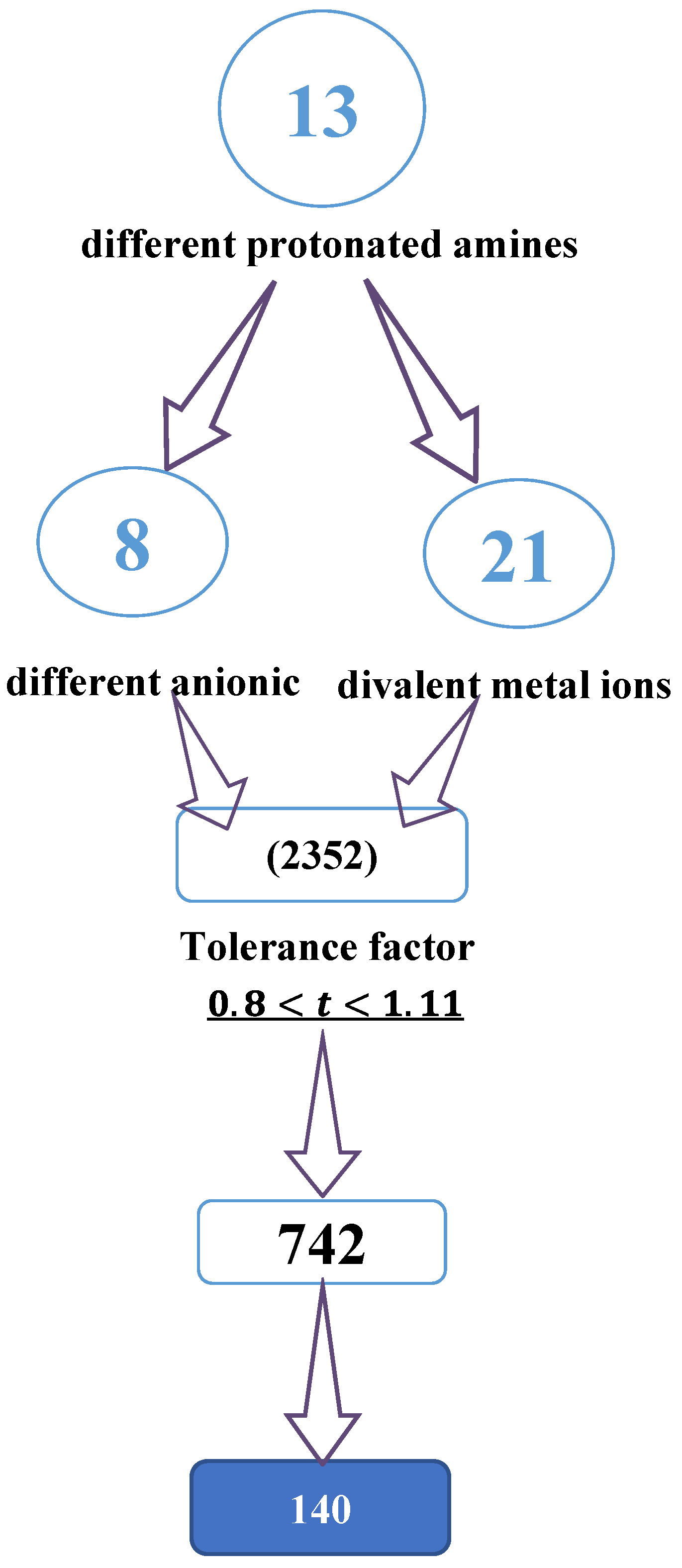
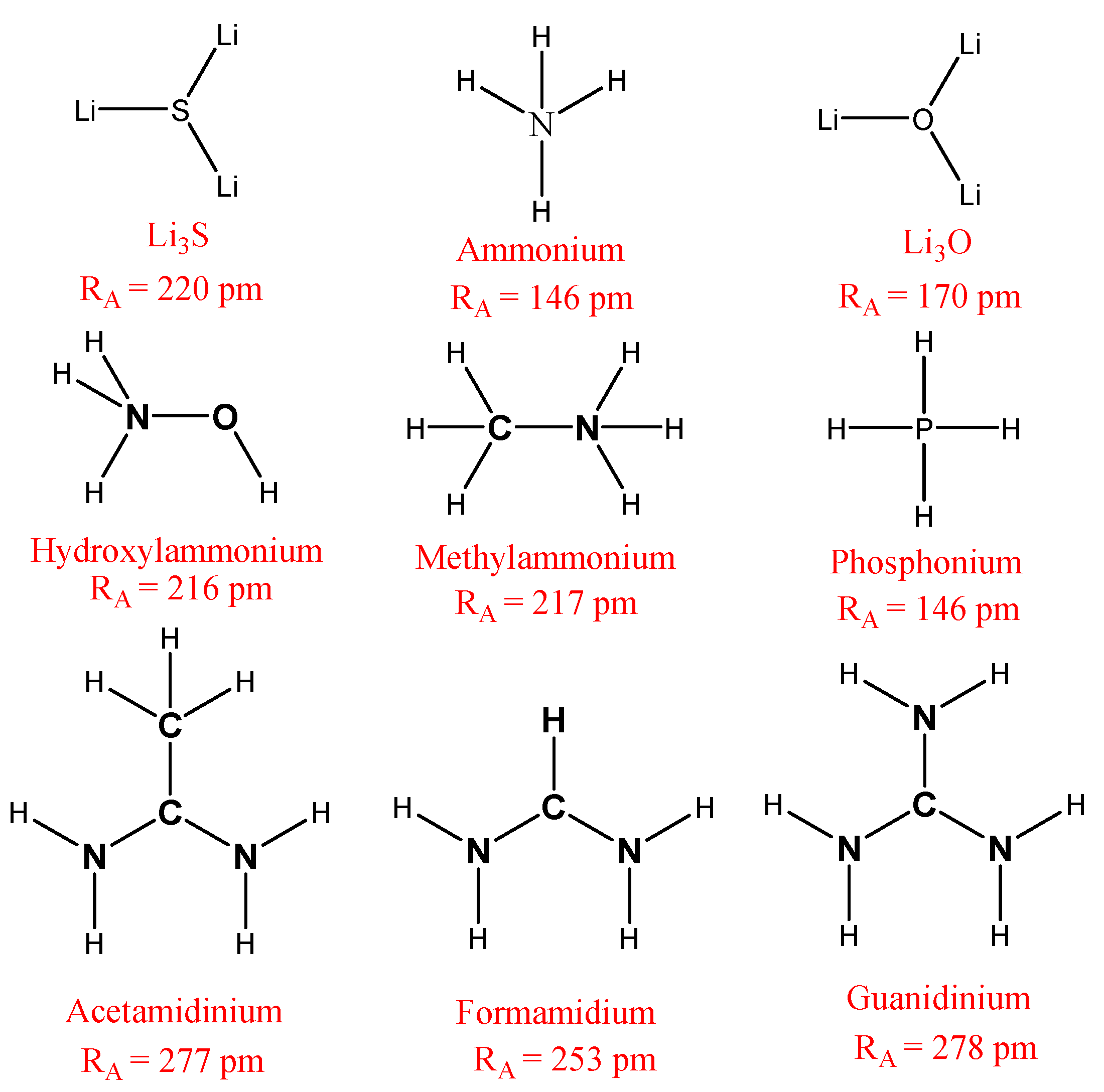

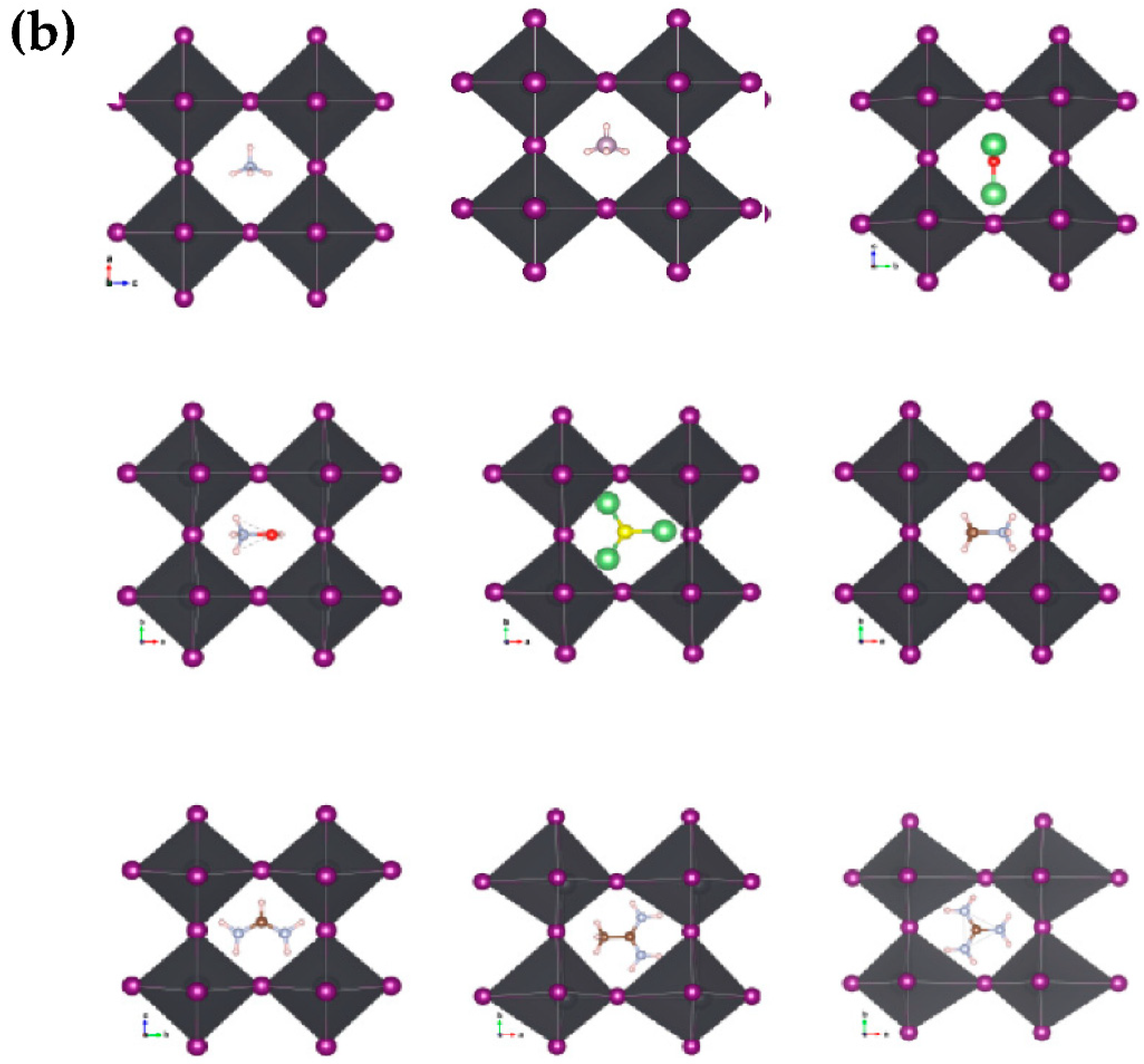
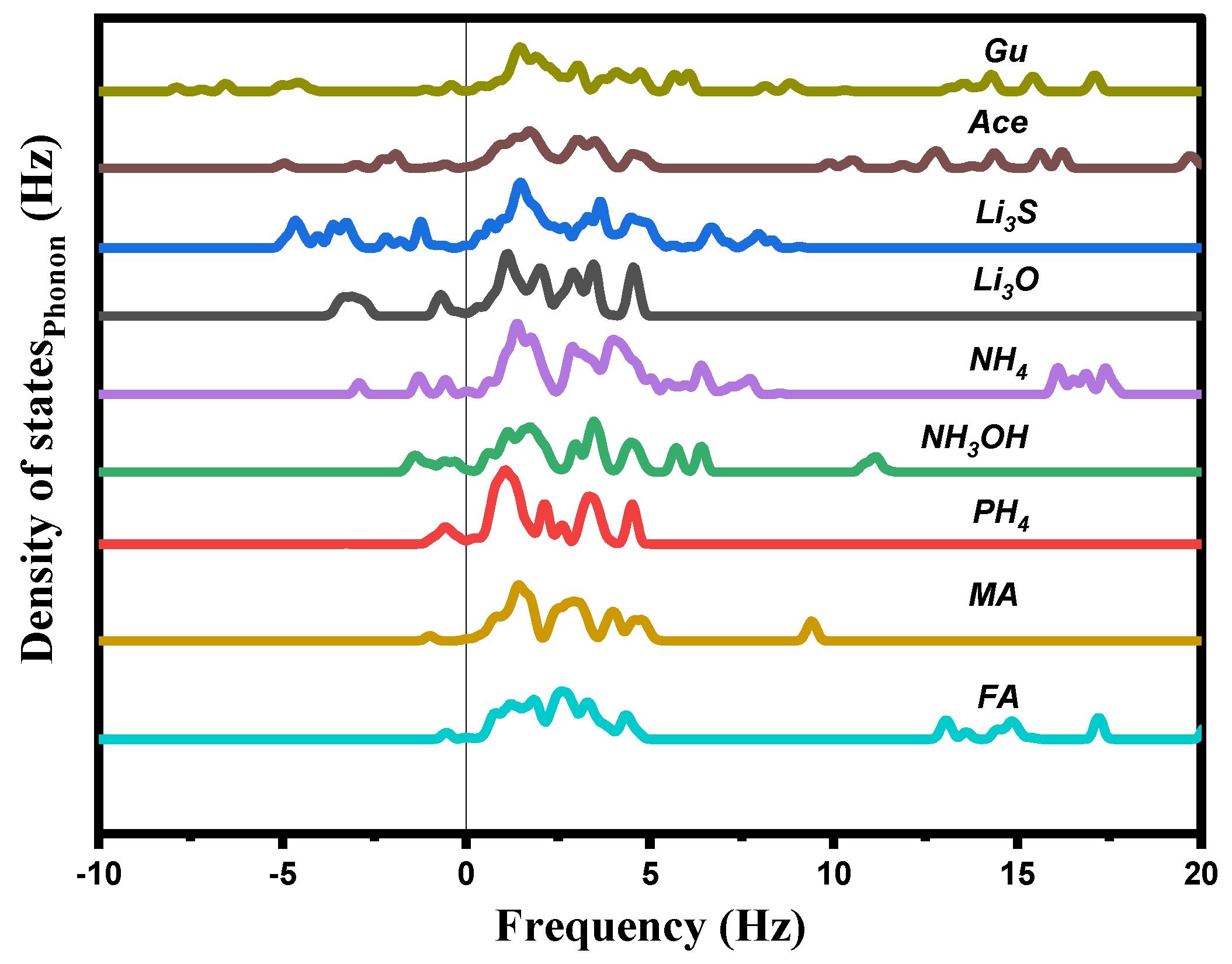
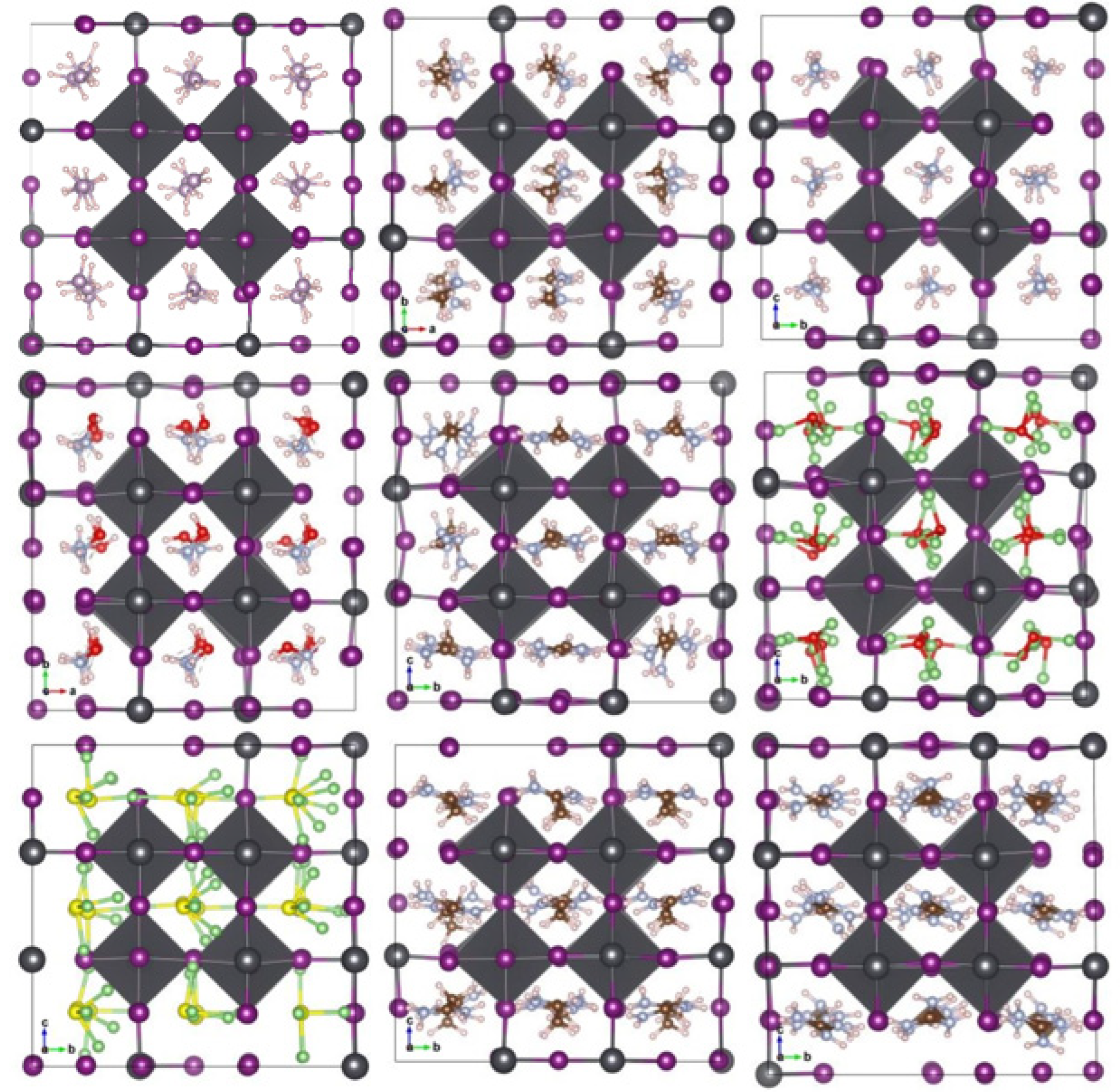
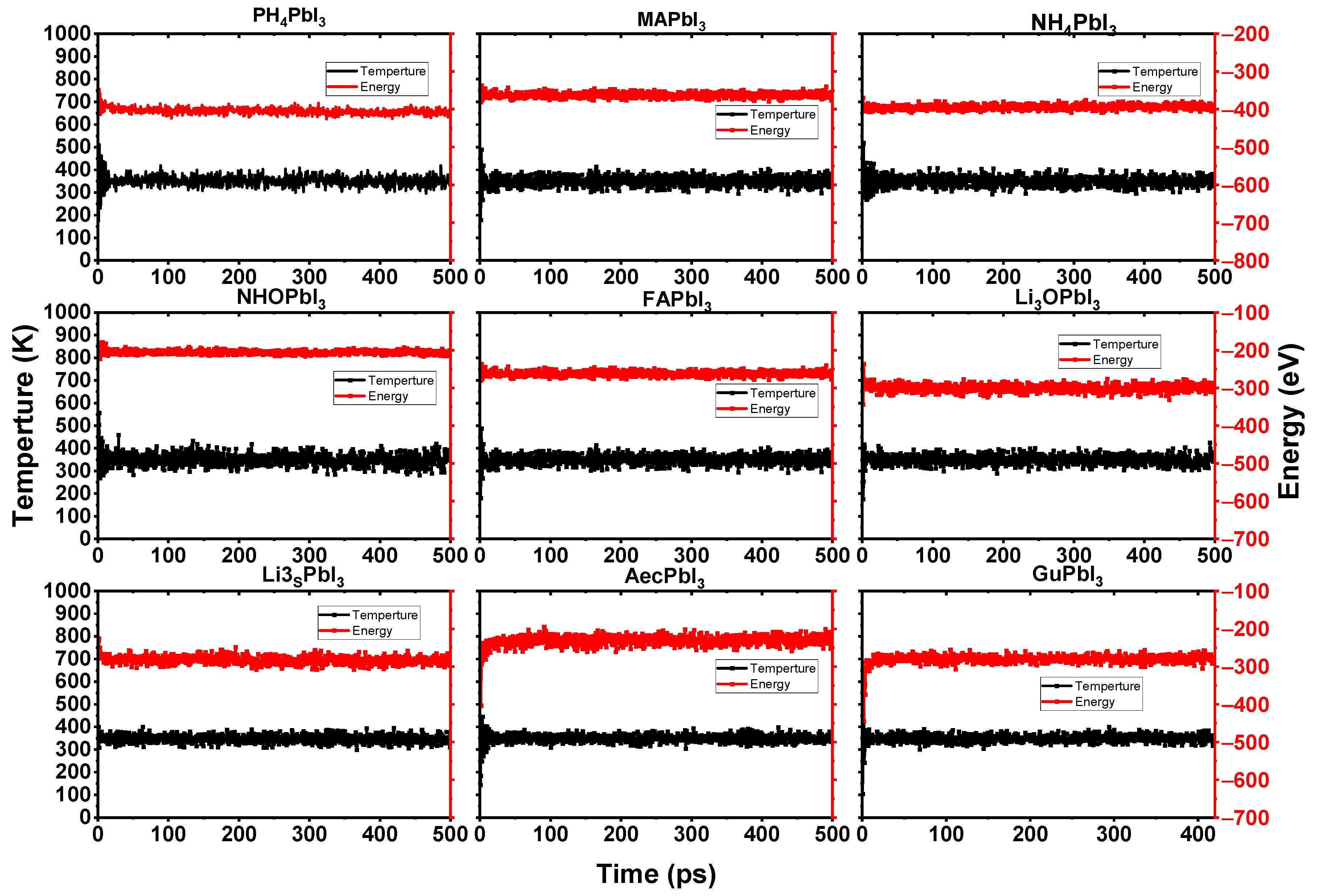
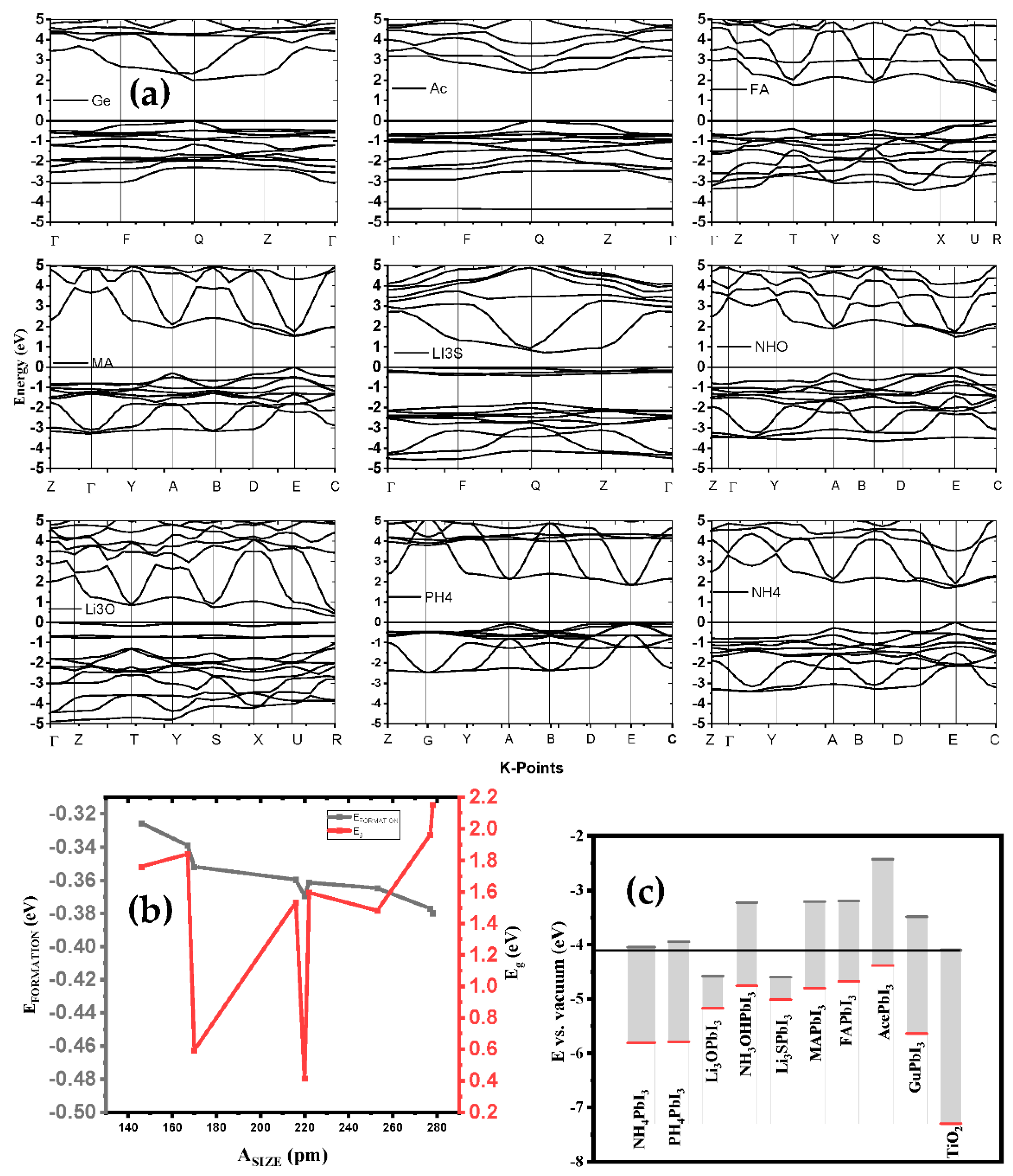

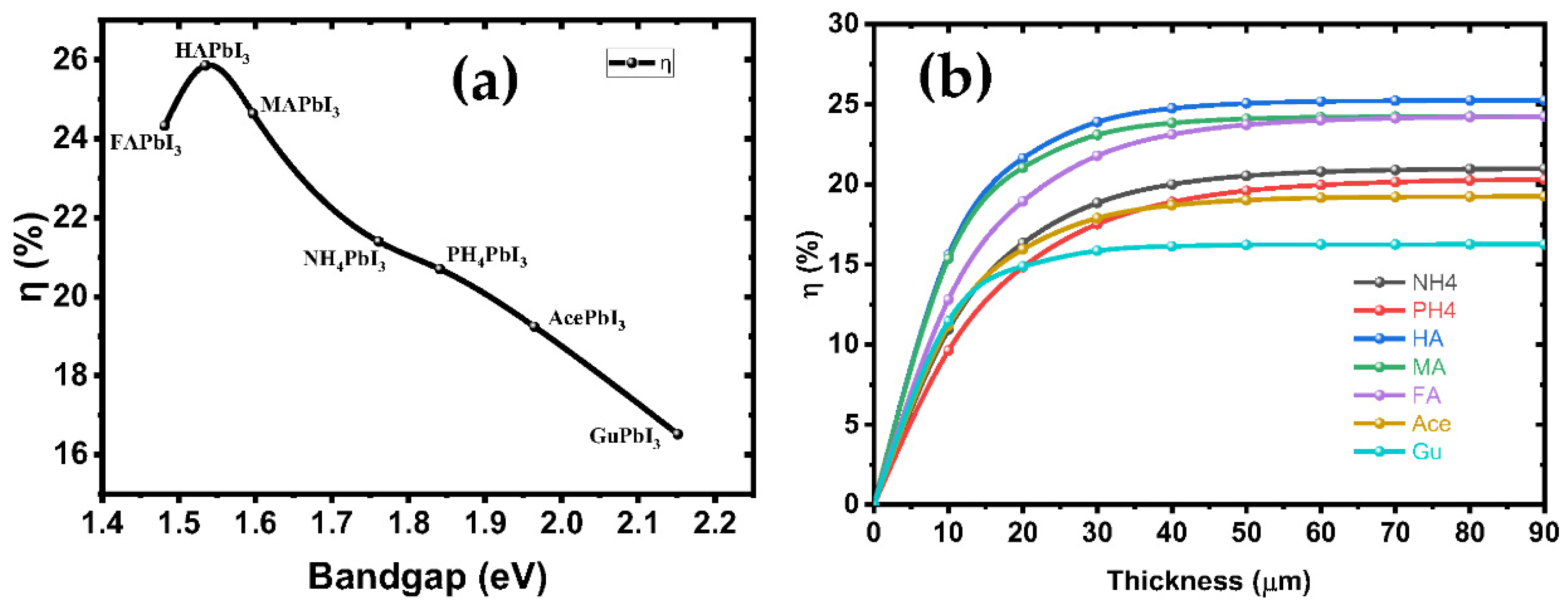
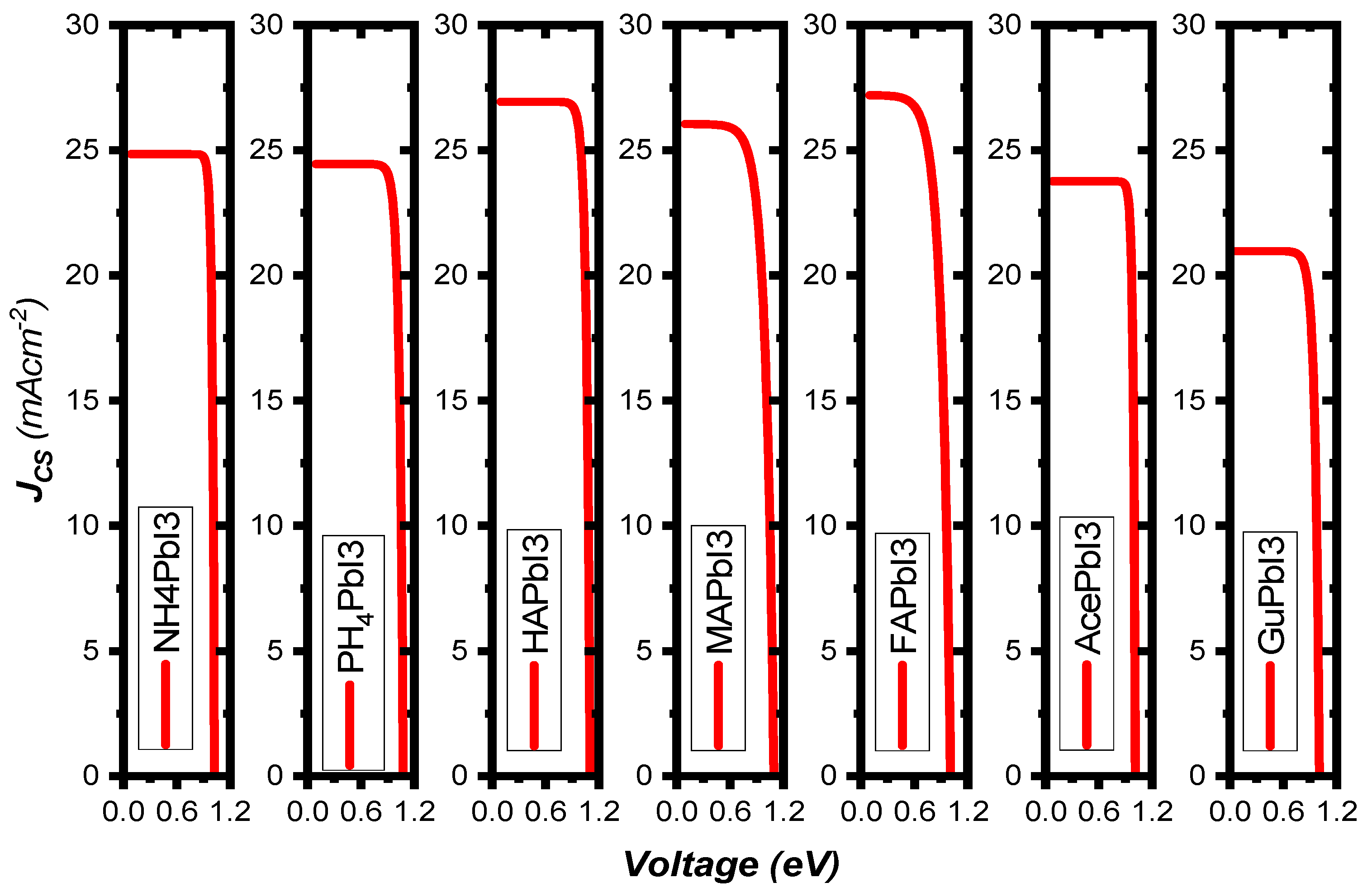
| a (Å) | b (Å) | c (Å) | α (°) | β (°) | γ (°) | Space Group | |
|---|---|---|---|---|---|---|---|
| NH4PbI3 | 6.3079 | 6.2407 | 6.3912 | 90.0000 | 90.0000 | 90.0000 | P m |
| PH4PbI3 | 6.5455 | 6.5483 | 6.5574 | 90.0000 | 88.7342 | 90.0000 | P m |
| Lis3OPbI3 | 6.8934 | 6.9410 | 6.9572 | 90.0000 | 90.0000 | 90.0000 | P m m 2 |
| HAPbI3 | 6.3388 | 6.3572 | 6.3517 | 90.0000 | 84.496 | 90.0000 | P m |
| Li3SPbI3 | 6.6913 | 6.6140 | 6.5984 | 89.0179 | 90.4295 | 90.7352 | P1 |
| MAPbI3 | 6.4271 | 6.4006 | 6.4547 | 90.0000 | 90.1803 | 90.0000 | P m |
| FAPbI3 | 6.4918 | 6.5457 | 6.3295 | 90.0000 | 90.0000 | 90.0000 | P m m 2 |
| AcePbI3 | 7.6505 | 7.0395 | 6.2866 | 90.2916 | 90.0465 | 90.2715 | P1 |
| GuPbI3 | 7.2249 | 6.5031 | 6.4847 | 90.5220 | 89.8453 | 89.5245 | P1 |
| RA (pm) | Eg (eV) | Ef (eV) | μ | t | |
|---|---|---|---|---|---|
| NH4PbI3 | 146 | 1.7611 | −0.32564 | 0.468182 | 0.801242 |
| PH4PbI3 | 167 | 1.8411 | −0.34885 | 0.468182 | 0.847215 |
| [Li3O] PbI3 | 170 | 0.5932 | −0.34170 | 0.468182 | 0.853782 |
| HAPbI3 | 216 | 1.5348 | −0.35955 | 0.468182 | 0.954485 |
| [Li3S] PbI3 | 220 | 0.4146 | −0.34944 | 0.468182 | 0.963241 |
| MAPbI3 | 222 | 1.5971 | −0.36116 | 0.468182 | 0.967620 |
| FAPbI3 | 253 | 1.4815 | −0.36469 | 0.468182 | 1.035485 |
| AcePbI3 | 277 | 1.9645 | −0.37708 | 0.468182 | 1.088025 |
| GuPbI3 | 278 | 2.1517 | −0.37980 | 0.468182 | 1.090214 |
| JCS | FF | VOC | η (%) | Eg | |
|---|---|---|---|---|---|
| NH4PbI3 | 24.84 | 66.4391 | 1.02 | 21.39543 | 1.7611 |
| PH4PbI3 | 24.45 | 62.3652 | 1.05 | 20.34961 | 1.8410 |
| HAPbI3 | 26.94 | 68.6404 | 1.10 | 25.84328 | 1.5348 |
| MAPbI3 | 26.04 | 68.2843 | 1.09 | 24.63394 | 1.5971 |
| FAPbI3 | 27.38 | 69.4876 | 1.006 | 24.32676 | 1.4815 |
| AcePbI3 | 23.75 | 63.1115 | 1.01 | 19.24151 | 1.9645 |
| GuPbI3 | 20.97 | 61.6615 | 1.005 | 16.51673 | 2.1517 |
Publisher’s Note: MDPI stays neutral with regard to jurisdictional claims in published maps and institutional affiliations. |
© 2022 by the authors. Licensee MDPI, Basel, Switzerland. This article is an open access article distributed under the terms and conditions of the Creative Commons Attribution (CC BY) license (https://creativecommons.org/licenses/by/4.0/).
Share and Cite
Al-Shami, A.; Sibari, A.; El Kenz, A.; Benyoussef, A.; El Moutaouakil, A.; Mounkachi, O. Improved Power Conversion Efficiency with Tunable Electronic Structures of the Cation-Engineered [Ai]PbI3 Perovskites for Solar Cells: First-Principles Calculations. Int. J. Mol. Sci. 2022, 23, 13556. https://doi.org/10.3390/ijms232113556
Al-Shami A, Sibari A, El Kenz A, Benyoussef A, El Moutaouakil A, Mounkachi O. Improved Power Conversion Efficiency with Tunable Electronic Structures of the Cation-Engineered [Ai]PbI3 Perovskites for Solar Cells: First-Principles Calculations. International Journal of Molecular Sciences. 2022; 23(21):13556. https://doi.org/10.3390/ijms232113556
Chicago/Turabian StyleAl-Shami, Ahmed, Anass Sibari, Abdallah El Kenz, Abdelilah Benyoussef, Amine El Moutaouakil, and Omar Mounkachi. 2022. "Improved Power Conversion Efficiency with Tunable Electronic Structures of the Cation-Engineered [Ai]PbI3 Perovskites for Solar Cells: First-Principles Calculations" International Journal of Molecular Sciences 23, no. 21: 13556. https://doi.org/10.3390/ijms232113556
APA StyleAl-Shami, A., Sibari, A., El Kenz, A., Benyoussef, A., El Moutaouakil, A., & Mounkachi, O. (2022). Improved Power Conversion Efficiency with Tunable Electronic Structures of the Cation-Engineered [Ai]PbI3 Perovskites for Solar Cells: First-Principles Calculations. International Journal of Molecular Sciences, 23(21), 13556. https://doi.org/10.3390/ijms232113556







